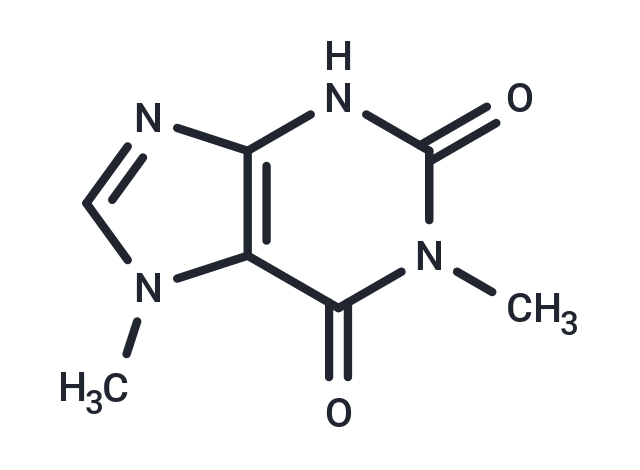Shopping Cart
- Remove All
 Your shopping cart is currently empty
Your shopping cart is currently empty

Paraxanthine (1,7-dimethylxanthine) is a metabolite of caffeine (sc-202514) which functions as an adenosine receptor ligand and a PARP-1 inhibitor in pulmonary epithelial cells. Studies suggest that Paraxanthine is structurally similar to caffeine and possibly mediates the physiological effects of caffeine. Also Paraxanthine acts as a competitive phosphodiesterase inhibitor, which increases intracellular cAMP, activates PKA, inhibits TNF-α and leukotriene synthesis. In addition, Paraxanthine acts as a Na+/K+ ATPase enzymatic effector.

| Pack Size | Price | Availability | Quantity |
|---|---|---|---|
| 25 mg | $57 | In Stock | |
| 50 mg | $85 | In Stock | |
| 100 mg | $121 | In Stock | |
| 200 mg | $179 | In Stock |
| Description | Paraxanthine (1,7-dimethylxanthine) is a metabolite of caffeine (sc-202514) which functions as an adenosine receptor ligand and a PARP-1 inhibitor in pulmonary epithelial cells. Studies suggest that Paraxanthine is structurally similar to caffeine and possibly mediates the physiological effects of caffeine. Also Paraxanthine acts as a competitive phosphodiesterase inhibitor, which increases intracellular cAMP, activates PKA, inhibits TNF-α and leukotriene synthesis. In addition, Paraxanthine acts as a Na+/K+ ATPase enzymatic effector. |
| In vitro | Upon prolonged exposure to Paraxanthine (PX), there is a dose-dependent increase in the count of TH+ neurons within cultures, with the effect becoming significant at concentrations starting from 100 μM and reaching an optimum between 800 and 1000 μM at 10 days in vitro (DIV). This suggests that Paraxanthine likely contributes to the prevention of dopaminergic (DA) neuron loss. Comparatively, Glial cell line-derived neurotrophic factor (GDNF), a prime growth factor for DA neurons, exhibits only a marginally stronger efficacy than 800 μM of Paraxanthine in DA neuron rescue after 10 and 16 DIV, at its optimal concentration of 20 ng/mL. Notably, Paraxanthine, which is formed through N3-demethylation of approximately 80% of caffeine, is significantly more effective than caffeine in promoting DA neuron survival. For instance, while 800 μM of caffeine results in a modest 40% increase in TH+ neuron count at 10 DIV, an identical concentration of Paraxanthine achieves an optimal enhancement in DA cell survival, indicated by a 169% increase. |
| Alias | 1,7-DIMETHYLXANTHINE |
| Molecular Weight | 180.16 |
| Formula | C7H8N4O2 |
| Cas No. | 611-59-6 |
| Smiles | Cn1cnc2[nH]c(=O)n(C)c(=O)c12 |
| Relative Density. | 1.6 g/cm3 |
| Storage | Powder: -20°C for 3 years | In solvent: -80°C for 1 year | Shipping with blue ice. | ||||||||||||||||||||||||||||||
| Solubility Information | H2O: 1 mg/mL (5.55 mM), Sonication is recommended. DMSO: 5.5 mg/mL (30.53 mM), Sonication is recommended. | ||||||||||||||||||||||||||||||
Solution Preparation Table | |||||||||||||||||||||||||||||||
H2O/DMSO
DMSO
| |||||||||||||||||||||||||||||||

Copyright © 2015-2025 TargetMol Chemicals Inc. All Rights Reserved.